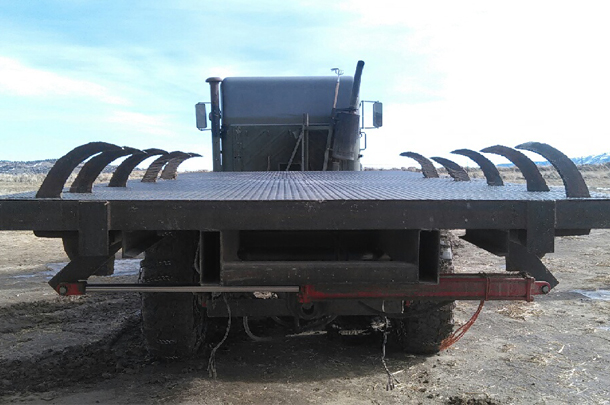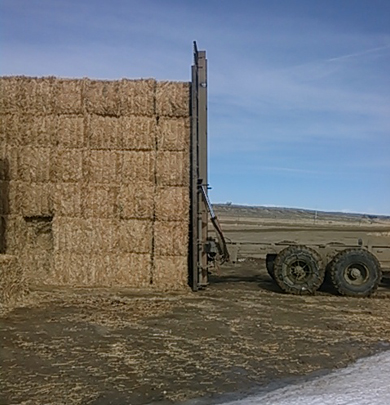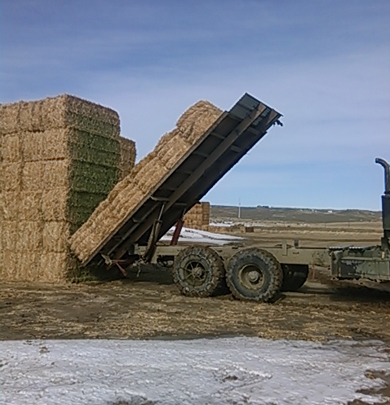Bill Kossert, his son Scott and his brother John have worked on the YZ Ranch west of Casper since 1977, and like many ranchers, they got tired of tearing up pickups and running loaders through the winter in order to feed their 350 head of cattle.
Since the Kosserts’ haystacks are scattered all over the ranch, most of their time was spent driving a loader to and from each stack. So, in order to save time and cut the ever-pressing fuel costs, Scott Kossert came up with the idea of transforming an old army truck into a self-loading feed truck.

“During the summer, we use one of those ProAG bale stackers to haul our hay, so my son got the idea to design something similar to that for our winter feeding,” says Bill Kossert. “So we went ahead and bought an army truck, and we built a flatbed that raises straight up with five curved metal teeth on each side. We also mounted a few hydraulic rams that we had on hand to the bed and to the teeth.”
Bill Kossert says the way it works is pretty simple. He begins by squaring the truck up with the haystack, and then he raises the bed into vertical position, backs up until the bed gently pushes on the stack, drives the teeth into the stack, slowly lowers the bed with six 3-by-3 bales, and goes out to feed.
“It’s pretty slick,” says Bill Kossert. “We are done feeding in about 90 minutes, and we cover several miles doing that. If you’re running your loader and you’re trailing or something like that, it takes half a day to make that circle. It works great for what we do, and it saves our pickups and our time for sure.”
Another big advantage to the Kosserts’ self-loading truck is that it only takes one person to operate. They designed it so that once it is loaded, Bill, Scott or John can put it in lower range and swing out of the cab and into the back to start feeding without having another person there.

If that isn’t impressive enough, the Kosserts also built a little walkway on the front end of the truck to make it easier to feed the first bale. They also took it a step further by installing electric hydraulic valves and two toggle switches to control the bed and the teeth from the inside, which keeps the cab from getting cluttered.
For such a big piece of equipment, Bill Kossert points out that there really isn’t much cost associated with it. He says they bought the army truck used from a ranch supply in town for $13,000. They didn’t have to purchase an army truck of that size, but he says one day they plan to mount a feeder to its front end.
The bed of the truck is 8 feet wide and 18 feet long, and cost them about $8,000. The curved metal teeth on the back were patterned off of the teeth that are on their ProAG bale stacker. They built each tooth out of half-inch thick scrap metal that they found at the local recycling shop.
According to Bill Kossert, the size of the teeth matters tremendously. He recommends to any rancher wanting to build a similar feed truck to use thicker metal when constructing the teeth. He says that oftentimes when he tries to load frozen bales, the half-inch thick metal will bend, but other than that, he hasn’t seen any problems with the truck.

“This was largely my son’s idea,” Bill Kossert says. “He did most of the designing, and he cobbled up the teeth, and we mounted it on the truck and went out and tried it, and it worked! So we just started running it. We didn’t have to come back and modify things.”
From start to finish, Bill Kossert says it only took them about three weeks to finish. He says it wouldn’t have taken that long, but as every rancher knows, other projects kept getting in the way.
“All you really need is a welder and a little bit of knowledge about hydraulics, but it’s really a pretty simple and straightforward deal,” Bill Kossert says. “This truck has really worked great for us. We had a big snow here, and it just walks right through it. We don’t need a loader anymore, and we don’t rip up our pickups. It just goes through mud and snow and it works good. We’ve enjoyed having it on the ranch, that’s for sure.” ![]()
Email Bill Kossert for questions regarding this project.
See how the self-loading feed truck works in the video below. Video courtesy of Bill Kossert.

Cassidy Woolsey
- Editor
- Progressive Cattleman
- Email Cassidy Woolsey
PHOTO 1: Since the Kossert family built the self-loading feed truck, they have been able to significantly decrease the amount of time they spend feeding.
PHOTO 2: A total of 10 curved teeth – five on each side – were built to come up through the bed and enter the bottom four bales. The last four teeth hold the end bale to keep it from breaking from the weight of the remaining bales.
PHOTO 3: The bed was designed to go from a standard flat position to 95 degrees vertical.
PHOTO 4: The bed was designed to load six bales at a time. Photos provided by Bill Kossert.







